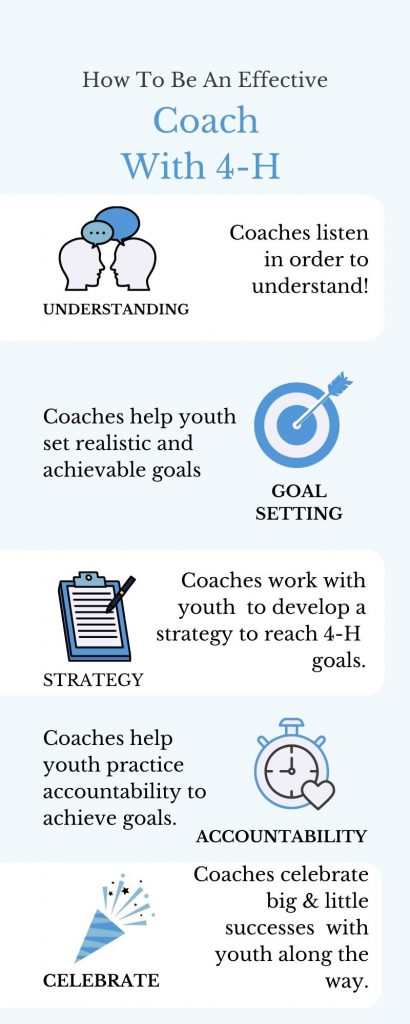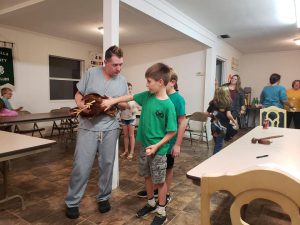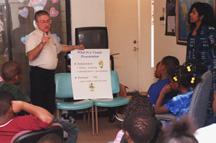by Rachel Pienta | May 26, 2023
What does it mean to be a coach? When you hear the word coach, do you picture someone with a whistle on a sports field? Most of us are probably familiar with sports coaching. However, the concept of coaching has grown to include life and professional coaching as well! This expansion of coaching has established that it is a skill that has applications across a broad array of life situations.
If you google professional coaching, you will find a plethora of books available on the topic. Writer Julie Starr has identified several fundamental coaching skills: building rapport, listening, asking good questions, and giving constructive feedback (Starr, 2021). Those skills sound like the characteristics agents hope to find in a 4-H volunteer!
How Is Coaching Different From Mentoring?
How does coaching differ from mentoring? Zust (2017) contrasted coaching versus mentoring in the business setting, explaining that coaching is a partnership between the coach and the person receiving coaching. The coach helps an individual or team reach or grow toward their potential. Just as a sports coach has a season, a coach in the business setting helps the person or team to reach a goal. How does coaching translate to the 4-H setting? In 4-H, youth may want to complete a project or compete in an event. As a volunteer, you can help coach them through a successful experience! In contrast, Zust (2017) characterizes mentoring as a longer term, developmental process that may not be focused on one particular event or project. In an earlier blog post, I addressed types of mentoring and mentoring practices.
As a volunteer, you may recognize that the 4-H agent you work with has been coaching you! As a 4-H club volunteer, you also have the opportunity to coach the youth enrolled in the 4-H program. In this blog post, you will learn about coaching techniques and how to be a more effective coach to the youth in your clubs. What does it mean to be effective as a coach? In the context of youth development, coaching effectiveness can be defined as the integrated application of “professional, interpersonal, and intrapersonal knowledge to improve youth competence, confidence, connection and character” (Vella et al, 2011).

4-H coaches help youth achieve their goals.
Getting in the Zone (of Proximal Development)
To better understand how to effectively implement coaching with youth, we will consider the following learning concepts: the Zone of Proximal Development (ZPD) and “scaffolding” (Vinson and Parker, 2019). Vygotsky (1978) defined ZPD as the “distance between actual developmental level as determined by independent problem-solving and the level of potential development as determined through problem-solving under adult guidance or in collaboration with more capable peers.” When I read Vygotsky’s definition of ZPD, I immediately think, “That’s 4-H!” Youth are able to develop and improve skills, ultimately achieving more with the support of caring adults. In 4-H, we also encourage youth to apply what they have learned through teaching others. Several coaching behaviors suggested by Vygotsky include “questioning, demonstrating and introducing the beginnings of task solution” (Vinson and Parker, 2019). These behaviors are ways to use scaffolding as a technique in youth development.
How to Incorporate Scaffolding into Your Coaching Toolkit
Scaffolding is a learning process that can be used as a technique in effective coaching. This technique can help youth build on existing knowledge they have previously acquired. The process works similarly for skill-building and “Scaffolding practices provide the opportunity for children to reach higher-level skills by building on and extending their existing skills” (Mincemoyer, 2016). Three examples of scaffolding strategies that can be used to coach 4-H youth include:
- Modeling and demonstrating: Adult volunteers can demonstrate the skill or ask a youth to demonstrate.
- Incorporating reflection into the club meeting: Build in time for youth to explain to you and their peers what they learned during a club activity.
- Using documentation: Illustrated talks and project books are forms of documentation. Youth may document their learning with photographs, written descriptions, and even video. This documentation becomes a foundation to build on moving forward as more skills are developed.
(Adapted from Mincemoyer, 2016).
In closing, you may already be engaging in effective coaching strategies as a 4-H volunteer without knowing that was what you were doing! If coaching is a new concept for you, this blog post should serve as a starting point for further development in your volunteer experience. Your 4-H agent can be an excellent knowledge resource as well as serving in a coaching role for you.
For more information about positive youth development (PYD) strategies or to learn more about becoming a 4-H volunteer, reach out to your local Extension office.

Youth engage in a mock Cooking Challenge with coach support.
Resources for Further Reading
Mincemoyer, C. (2016). “Scaffolding Approaches and Practices.” Penn State Extension. Pennsylvania State University. http://bkc-od-media.vmhost.psu.edu/documents/HO_MIL_GI_Scaffolding.pdf
Starr, J. (2021). The Coaching Manual. 5th edition. Pearson Business.
Vella, Stewart & Oades, Lindsay & Crowe, Trevor. (2011). The Role of the Coach in Facilitating Positive Youth Development: Moving from Theory to Practice. Journal of Applied Sport Psychology. 23. 33-48. 10.1080/10413200.2010.511423.
Vinson, D. and Parker, A. (2019) Vygotsky and Sports Coaching: Non-linear practice in youth and adult settings. Curriculum Studies in Health and Physical Education, 10 (1). pp. 91-106. doi:10.1080/25742981.2018.1555003 ORCID: 0000-0001-6842-3067
Vygotsky, L. S. (1978). Mind in Society: The development of higher psychological processes. Harvard: Harvard University Press.
Zust, C. (2017). “Know the Difference Between Coaching and Mentoring.” Kent State University. https://www.kent.edu/yourtrainingpartner/know-difference-between-coaching-and-mentoring

by Rachel Pienta | May 8, 2023
4-H functions most effectively as a youth-adult partnership that fosters positive youth development. Youth-adult partnerships can take several forms. One form is a mentoring relationship between a caring adult volunteer and a 4-H youth.
Mentoring is a relationship-based process that occurs over time. The mentoring process can be formal or informal. This blog post will explore what it means to be a mentor and the importance of mentoring roles in youth development. The person being mentored may be referred to as a protégé or as a mentee. Mentoring is not a one-way relationship. The relationship can fulfill professional and socioemotional needs for both mentor and protégé (Inzer & Crawford, 2005).
Formal mentoring tends to occur within an organizational structure. A senior member of an organization or an adult may be assigned to serve in a mentoring role to a new member or to a youth. Informal mentoring relationships are voluntarily formed between two people who choose each other (Inzer & Crawford, 2005). A third, hybrid approach known as youth-initiated mentoring (YIM) is also an option as a model and may be optimal for building mentor relationships in 4-H programs (van Dam L. B., 2021).

Mentors play one or more of these five roles for mentees.
5 Roles of the Mentor
The following mentoring roles can be accomplished within a formal or informal mentor relationship:
- Goal Setter: Help identify and prioritize the goals of the person you are mentoring.
- Adviser: Provide advice and guidance, often based on life experience and organizational knowledge.
- Cheerleader: Encourage positive actions and celebrate success.
- Growth Cultivator: Suggest activities that will help the person grow.
- Role Model: Serve as a model of potential success and provide real-life examples of how to surmount obstacles.
Goal Setter: The mentor as goal setter helps the youth to identify potential goals to set. Mentors can also play an important role in teaching youth how to balance and prioritize goals. For example, Susy may want to win a blue ribbon at the livestock show. At the same time, Susy is also trying to maintain a 4.0-grade average and work part-time. Susy’s mentor can help her to set realistic goals that help her to develop time management skills.
Adviser: It can be helpful for youth to learn from the experiences of others. For example, Michael wants to become state 4-H president. He has connected with adult volunteer Cory, who was state president when he was a 4-H youth. Cory serves as a sounding board and often shares how he learned from mistakes and was able to build on his successes to achieve his leadership goal.
Cheerleader: The cheerleader role may seem simple but also the most important. Celebrating youth successes – whether large or small – can make a big difference in a child’s life. Marking success with recognition and encouragement helps to reinforce positive behavior and helps to build a foundation for continued achievement. For example, Anna has been working on her aim during archer
y club practice. She wants to compete in an upcoming match. You observe her stance and coach her to adjust her posture. Anna is now able to hit the center target three out of four times. You praise her improvement and celebrate the achievement with her, sharing an exuberant high five.
Growth Cultivator: 4-H professionals and volunteers often refer to growing leaders and “making the best better” – the growth cultivator does these things. As a growth cultivator, a mentor helps to point youth in the direction of the next and most appropriate challenge that will help foster positive development. For example, Nathan has prepared a strong project board display for the county fair. You suggest he use that project board to develop an illustrated talk for district showcase.
Role Model: Serving as a role model for youth may seem like a full-time job! However, the key part of being a role model is honesty. Role models do not have to be perfect, but modeling honesty and how to be accountable when mistakes are made are critical elements of being a good role model. For example, you are usually early to club activities, greeting everyone with a smile and a personal acknowledgment when they come through the door. On the way to a district council meeting, you encounter heavy traffic and run late. When you arrive, your club youth members are already there and a 4-H agent has started the meeting. At the break, you shrug off your poor mood and tell your youth, “I didn’t leave early enough to allow for rush hour traffic. That is on me. I appreciate how you were all here on time and were able to participate in the meeting before I arrived.”
3 Key Elements of Effective Mentoring
A robust, growing body of research on youth mentoring suggests that a hybrid model of targeted mentoring and relational bond mentoring may produce the best outcomes for youth development (Christensen, 2020). Targeted mentoring involves a relationship focusing on a specific outcome or behavior – such as academic or career mentoring. Relational bond mentoring focuses on developing rapport and may present a more holistic approach. 4-H is built on a developmental model that uses this hybrid approach. Youth-adult relationships may initially form to reach specific goals – such as completing a project. Over time, as the youth becomes more involved with the program, relational bonds may develop. Research by Raposa et al (2019) suggests that effective youth mentoring involves an “interconnected set of three processes (i.e., social-emotional, cognitive, and identity formation processes) through which the establishment of close, caring relationships with non-parental adults are expected to promote positive developmental trajectories” (Raposa, 2019). Effective youth mentoring is likely to incorporate all three of these elements: social-emotional, cognitive, and identity formation processes.
How Does Youth-Initiated Mentoring (YIM) Work?
4-H can have an important role in providing a structured, safe environment where youth choose and develop mentoring relationships. One way to establish these type of mentoring relationships is youth-initiated mentoring (YIM). YIM is a hybrid approach in which youths and their families are helped to identify and recruit caring adult mentors from within their existing social networks (van Dam L. R., 2021).
The 4-H youth-adult partnership model provides a structure for helping youth to identify, recruit, and maintain connections with caring adults (van Dam L. B., 2021). The key elements in YIM are youth agency and choice in establishing and maintaining relationships.

Club leader teaches poultry anatomy to youth.
Which Type of Mentor Role Fits?
The mentor role that best fits you and your mentee may incorporate one or more of the five mentor roles. It is likely that at some point during a long-term mentoring relationship a mentor will have played all of the five roles in supporting their mentor.
Become a Mentor with 4-H!
As a 4-H volunteer, you will opportunities to serve as a mentor to youth looking to form relationships with caring adults. To learn more about how to get involved, reach out to your local UF/IFAS County Extension office.
References:
- Christensen, K. H. (2020). Non-Specific versus Targeted Approaches to Youth Mentoring: A Follow-up Meta-analysis. Journal of Youth and Adolescence, 959–972.
- Inzer, L., & Crawford, C. (2005). A Review of Formal and Informal Mentoring: Processes, Problems, and Design. Journal of Leadership Education, 33-50.
- Raposa, E. R. (2019). The Effects of Youth Mentoring Programs: A Meta-analysis of Outcome Studies. Journal of Youth and Adolescence, 423–443.
- van Dam, L. B. (2021). Youth Initiated Mentoring: A Meta-analytic Study of a Hybrid Approach to Youth Mentoring. J Youth Adolescence, 219–230.
- van Dam, L. R. (2021). Youth-Initiated Mentoring as a Scalable Approach to Addressing Mental Health Problems During the COVID-19 Crisis. JAMA Psychiatry, 818.
by Heather Kent | Mar 6, 2015
 Have you ever attended a meeting for the first time and felt a little out of place? Do you remember that nervous feeling; the pit in your stomach of not knowing anyone, not sure if you belonged? Creating a welcoming environment in 4-H clubs and events helps members and volunteers have a sense of belonging. A sense of belonging is one of the Essential Elements of Positive Youth Development. Last month, Georgene Bender and Jon Mayer shared ideas for creating a welcoming environment in your 4-H club during our February Make a Difference Monday session.
Have you ever attended a meeting for the first time and felt a little out of place? Do you remember that nervous feeling; the pit in your stomach of not knowing anyone, not sure if you belonged? Creating a welcoming environment in 4-H clubs and events helps members and volunteers have a sense of belonging. A sense of belonging is one of the Essential Elements of Positive Youth Development. Last month, Georgene Bender and Jon Mayer shared ideas for creating a welcoming environment in your 4-H club during our February Make a Difference Monday session.
1. Welcome new members– have a welcome committee for your club. This committee can be a group of members or even a 4-H family that is willing to come to the meeting early to welcome any new members. They could even prepare a welcome packet with 4-H enrollment information, club brochure, calendar, 4-H pen or pencil, or even a club t-shirt. You can ask your 4-H agent for some ideas or items to include in the welcome packet. There are many inexpensive “4-H trinkets” for $1.00 or less available at the 4-H Mall. Assigning 4-H families to mentor new 4-H families is also a great way to mentor and orient new members.
- Plan “get acquainted games”- it’s difficult to feel comfortable in a group when you don’t know people well. Leading get acquainted activities during club meetings (especially at the beginning of the club year) will help establish a friendlier club environment. Ice breakers, get acquainted games, or even roll calls that ask questions about member’s interests (answer roll by making the sound of your favorite animal) can help members get to know each other better.
- Encourage engagement– a great way to get new members involved is to use the 4-H Clover worksheet to help plan the club year. If the member joins after the club planning meeting, get them involved in a committee. Smaller committees are less intimidating and can help new members feel like they belong and have something to contribute.
What will you do this year to help make new members feel welcome? Leave us a comment below! To learn more about creating welcoming environments in 4-H clubs, you can view the full, 1-hour workshop online at http://florida4h.org/madmondays.






